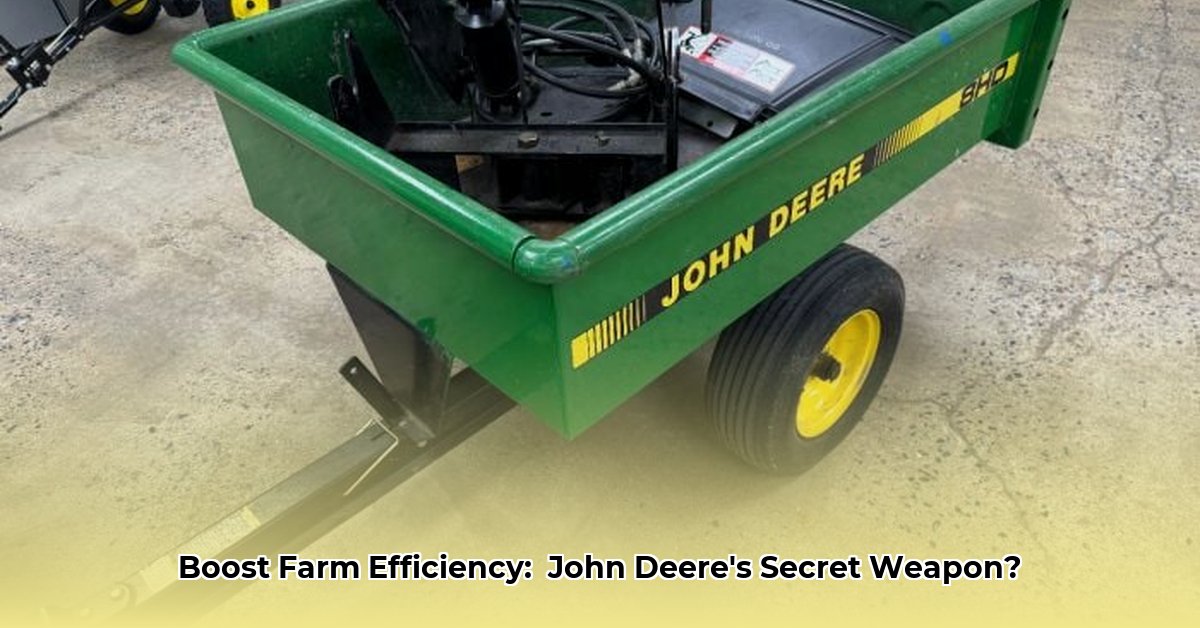
John Deere Lawn Tractor Cart: Boosting Your Farm's Bottom Line
Making farming easier without sacrificing quality is key. The John Deere 7 cu. ft. Poly Utility Cart (LP21935) aims to streamline operations, potentially boosting efficiency and long-term savings. For more toy tractor info, check out this John Deere Toy Tractors site.
Working Smarter, Not Harder: Efficiency on the Farm
Hauling supplies across fields can be incredibly taxing. The LP21935's 7 cubic foot capacity and 450-pound weight limit mean fewer trips, saving time. Its pneumatic tires and turf tread design reduce soil compaction compared to dragging heavy loads, improving soil health and potentially increasing crop yields. The simple dump mechanism facilitates quick unloading. Isn't maximizing your time a top priority?
Environmentally Friendly: Sustainable Practices in Action
Sustainable farming is crucial. The LP21935's durable polyethylene construction is rust-proof, reducing waste and resource consumption compared to metal carts. This longevity contributes positively to the farm's environmental footprint. How can we minimize our environmental impact while still maximizing productivity?
The Price of Progress: Weighing the Investment
The LP21935 represents a significant investment. It's not ideal for very small farms. The initial purchase price needs to be balanced against potential savings in time, labor, and reduced soil damage. Consider the long-term benefits: reduced soil compaction, less tractor wear, and potentially higher yields. Is this long-term investment justifiable for your operation?
Adapting to Your Needs: A Versatile Tool
The LP21935's molded channels and pockets allow for customization. Separate compartments for seeds, fertilizers, or tools improve organization, leading to better workflow and efficiency. This adaptability maximizes its effectiveness for your unique needs. How can you tailor this cart to meet precisely your farm's requirements?
Should You Buy One? Asking the Right Questions
Before purchasing, consider:
- Current Material Handling: How much time is spent on manual transport? Could the LP21935 significantly reduce this?
- Budget: Is the initial cost manageable? Are leasing options available?
- Terrain: Will the cart's maneuverability suffice on your fields?
- Versatility: How much customization is needed to optimize your workflow?
Taking Action: A Step-by-Step Approach
- Analyze Needs: Identify material handling bottlenecks.
- Compare Prices: Obtain quotes from dealers. Compare the LP21935's cost to ongoing manual labor costs.
- Test Drive (If Possible): Test the cart's performance on your land.
- Explore Financing: Inquire about financing or leasing options.
- Customize: Optimize the cart's organization for your specific needs.
The Good and the Not-So-Good: A Balanced Perspective
| Advantages | Disadvantages |
|---|---|
| High Capacity (7 cu ft, 450 lb) | Substantial Initial Investment |
| Durable, Rust-Proof Polyethylene Construction | Terrain Limitations (Steep Hills, Uneven Ground) |
| Streamlines Material Handling | Requires a Compatible Tractor |
| Easy Dump Mechanism | May Not Suit All Farm Sizes |
| Highly Adaptable Design (Customizable Compartments) | Long-Term Durability Requires Observation |
The LP21935's effectiveness depends on its integration into your farming strategy. Careful pre-purchase planning is essential.
How to Reduce Environmental Impact Using John Deere LP21935 Poly Cart
Key Takeaways:
- The LP21935 can improve farm efficiency, reducing fuel consumption and emissions.
- Its overall environmental impact depends on manufacturing and disposal practices. Further data is needed.
- Sustainable farming requires holistic approaches beyond single equipment choices.
- Consider the cart's long-term value within your broader farm management strategies.
Optimizing Farm Efficiency with the John Deere LP21935
The LP21935 reduces tractor trips, lowering fuel consumption and emissions. The durable polyethylene construction offers a positive – though potentially incomplete – environmental element. More data on its manufacturing and recycling is needed for a complete picture. How can we best quantify the positive environmental effects of this cart?
Beyond the Cart: A Holistic Approach to Sustainable Farming
The cart's environmental impact is linked to your overall farming practices. Its success in sustainable farming depends on its integration into broader strategies.
Analyzing Your Needs: Is the LP21935 Right for You?
Assess your farm's needs, terrain suitability, material transport volume, and the cart's capacity. A thorough assessment will ensure the cart is an effective asset.
Long-Term Considerations and Future Improvements
The cart's end-of-life management (recycling or landfill) is vital for evaluating its overall environmental impact. Long-term sustainability is as important as short-term gains.
Actionable Steps for Sustainable Farming
- Analyze your material handling to identify improvement areas.
- Evaluate the LP21935's suitability for your terrain and needs.
- Assess the cart's entire lifecycle for its sustainability.
- Explore other sustainable practices (crop rotation, water conservation).
- Advocate for transparent reporting on the environmental impact of agricultural equipment.